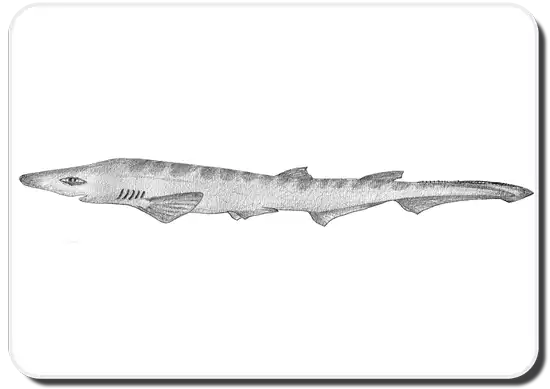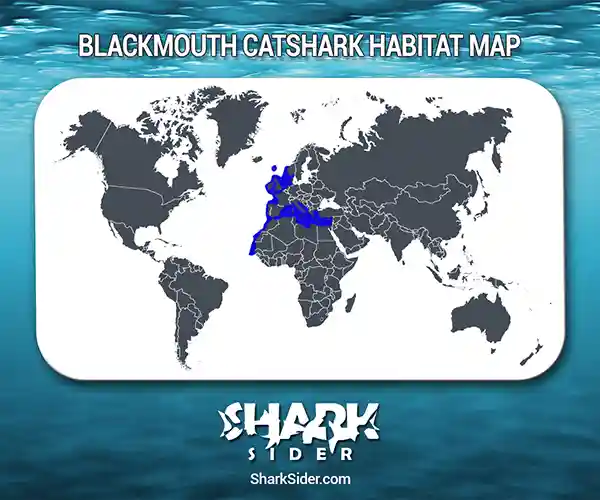Blackmouth catshark is a species of catshark found in the Atlantic Ocean, also known as the Black-mouthed dogfish. It gets its name from the characteristic black interior of its mouth. It is a slow-moving fish often seen resting motionless on the sea floor.
This species was first described by Constantine Samuel Rafinesque in 1810. The oldest fossils occurred 5.3-3.6 million years ago, during the Lower Pliocene era, and were found in the northern Apennines.

Blackmouth Catshark Scientific Classification |
|
| Kingdom | Animalia |
| Phylum | Chordata |
| Class | Chondrichthyes |
| Order | Carcharhiniformes |
| Family | Scyliorhinidae |
| Genus | Galeus |
| Scientific name | G. melastomus |
Description
They are one of the largest species of catsharks, with an average length of 50-79 cm (1.6-2.6 ft), and females are typically bigger than males. The sharks found in the Mediterranean are smaller in size compared to the Atlantic specimens. The maximum recorded weight was 1.4 kg (3.1 pounds).
Apart from its distinctive black mouth cavity, the blackmouth catshark has a long, pointed snout comprising roughly 6-9% of its total length. The eyes are large and oval. The mouth is short and widely arched, with 69 to 79 rows of teeth on the upper and lower jaw, respectively. It has five pairs of gills along its body, which is grayish-brown and has a lighter underside.There are 15-18 saddles along its back and tail, and the tips of the dorsal and caudal fins are white.
It has equal-sized dorsal fins placed far back on its body, with large pectoral fins and narrow pelvic fins. The anal fin is significantly bigger than the dorsal fins and comprises almost 13-18 % of the catshark’s body length. A crest of dermal denticles is present on the upper edge of the caudal fin.
Where do they live
Map Of The Blackmouth Catshark’s Habitat

The Blackmouth catshark is native to the northeastern Pacific Ocean and the Mediterranean Sea, ranging from Iceland and Norway to Senegal and the Azores, including the British Isles, The Faroe Islands, and the northern part of the Mid-Atlantic Ridge. It commonly inhabits muddy or sandy regions on the sea bed at depths of 150-1400 m (490-4,590 ft). However, specimens have been found in shallow waters off Norway’s coast and the eastern Pacific’s deep waters.
Juveniles are thought to prefer shallower water compared to adults, but there are differing studies regarding this theory.
Behavior
Dietary
The Blackmouth catshark feeds primarily on bottom-dwelling organisms such as shrimp, lobsters, krill, cephalopods, and bony fishes, depending on geographical availability. Crustaceans are essential prey for juveniles, while the adult catsharks prefer larger fish, sometimes even hunting other shark species.
Reproductive
Blackmouth catsharks are oviparous and typically lay between 2-8 eggs at a time, though they can lay up to 13 eggs at once. They reproduce year-round, though more eggs are laid in winter and summer. The egg case is distinctively vase-shaped, with a rounded lower portion and a squared-off upper portion having coiled horns at the corners. It is golden-brown when laid and becomes darker with exposure to seawater. The size of the egg sack varies with the size of the female. Those laid by the Atlantic sharks are generally bigger compared to the Mediterranean ones, and their maturation size is also greater.
Social
They are primarily nomadic but sometimes hunt in groups, as evidenced by remains found in their stomachs of organisms too large to be hunted by a single shark.
Adaptations
Unlike most sharks, the Blackmouth catshark relies on its eyesight and electroreception instead of its sense of smell to hunt prey. It hunts by swaying its head side to side and using sensors on its snout, called ampullae of Lorenzi, to detect electrical signals emitted by its prey. Their eyes are specially modified to detect bioluminescence, which most of their prey emits.
Blackmouth catsharks take advantage of the ground effect to save energy. Ground effect is a reduction in the drag force experienced by a wing when it moves close to the ground. This helps the shark cruise above the sea floor without exerting extra force.
Human interactions
This species is harmless to humans. It poses little economic value and is caught in large quantities as bycatch. In the northeastern Atlantic, it is now being targeted by fishing companies due to a decline in other shark species. In Portugal and Italy, its meat is consumed either fresh or salted and made into fish leather.
Recent catches in the Mediterranean have yielded mostly immature fish indicating a negative effect of fishing. Despite this, the numbers are stable. The IUCN has thus decided to keep its status as “Least Concern” or “LC.”
